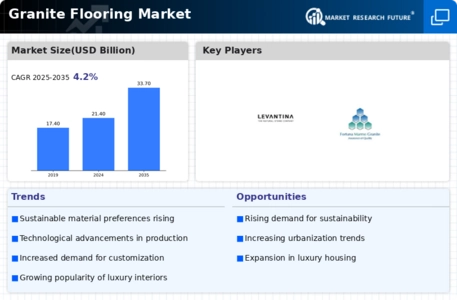Technological Advancements in Manufacturing
The Granite Flooring Market is experiencing a transformation due to technological advancements in manufacturing processes. Innovations in quarrying, cutting, and finishing techniques have enhanced the efficiency and precision of granite production. These advancements not only reduce production costs but also improve the quality and variety of granite flooring options available to consumers. Market data indicates that the introduction of advanced machinery and techniques has led to a wider range of designs and finishes, catering to diverse consumer preferences. As manufacturers adopt these technologies, the granite flooring market is likely to see an increase in product offerings, making it more competitive and appealing to a broader audience. This technological evolution is expected to play a crucial role in shaping the future of the granite flooring market.
Rising Demand for Durable Flooring Solutions
The Granite Flooring Market experiences a notable increase in demand for durable flooring solutions. As consumers become more discerning about the longevity and maintenance of flooring materials, granite emerges as a preferred choice due to its resilience and aesthetic appeal. The market data indicates that the durability of granite flooring can significantly reduce replacement costs over time, making it an economically viable option for both residential and commercial applications. This trend is particularly pronounced in regions with high foot traffic, where the need for robust flooring solutions is paramount. Consequently, the rising demand for durable flooring solutions is likely to propel the growth of the granite flooring market, as consumers prioritize quality and longevity in their purchasing decisions.
Increasing Awareness of Sustainable Materials
The Granite Flooring Market is influenced by a growing awareness of sustainable materials among consumers and builders. As environmental concerns gain prominence, there is a shift towards materials that are not only durable but also eco-friendly. Granite, being a natural stone, is often perceived as a sustainable choice due to its longevity and minimal maintenance requirements. Market data reveals that consumers are increasingly willing to invest in sustainable flooring options, which is likely to drive the demand for granite flooring. This trend is further supported by initiatives promoting sustainable building practices, encouraging the use of materials that have a lower environmental impact. As awareness of sustainability continues to rise, the granite flooring market is expected to benefit from this shift in consumer preferences.
Rising Consumer Preference for Aesthetic Appeal
The Granite Flooring Market is significantly influenced by the rising consumer preference for aesthetic appeal in flooring materials. As interior design trends evolve, homeowners and commercial property owners increasingly seek flooring solutions that enhance the visual appeal of their spaces. Granite flooring, with its unique patterns and colors, offers a luxurious and sophisticated look that aligns with contemporary design preferences. Market data suggests that the aesthetic qualities of granite are a key factor driving its popularity, particularly in high-end residential and commercial projects. This trend indicates a potential for growth in the granite flooring market, as consumers prioritize not only functionality but also the visual impact of their flooring choices. The emphasis on aesthetic appeal is likely to continue shaping consumer decisions in the granite flooring market.
Growth in Construction and Renovation Activities
The Granite Flooring Market is poised for growth, driven by an upsurge in construction and renovation activities. Recent statistics suggest that the construction sector is witnessing a resurgence, with increased investments in both residential and commercial projects. This growth is particularly evident in urban areas, where new developments and renovations of existing structures are on the rise. Granite flooring, known for its elegance and durability, is increasingly specified in architectural designs, enhancing the aesthetic value of spaces. The market data indicates that the demand for granite flooring in new constructions and renovations is expected to rise, as builders and homeowners alike seek high-quality materials that offer both functionality and style. This trend underscores the potential for sustained growth in the granite flooring market.


















Leave a Comment